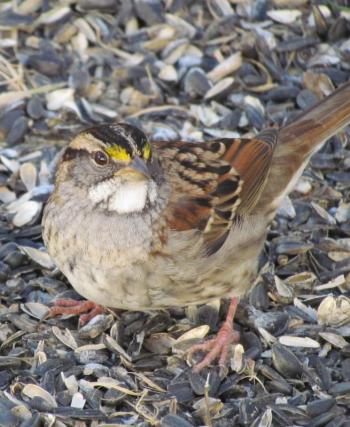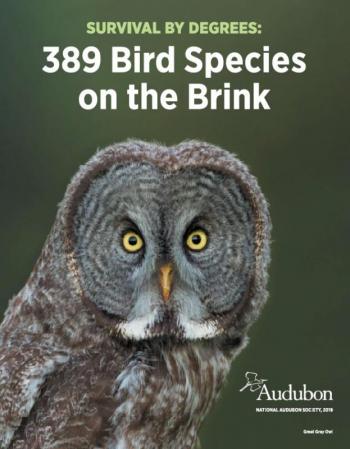Three Possible Futures for Maine’s Birds
The desire to look into the future seems to have obsessed humans for millennia. Stories of people with mystical powers to foretell events are found throughout ancient texts and oral traditions. Modern sci-fi and fantasy books and movies are chock full of time travel episodes. Even Charles Dickens, in his famous story “A Christmas Carol,” invokes the idea of peeking into what is to come when Scrooge is led to see one possible future by the scariest of the three ghosts that visit him in his fateful slumber.
Scientists have also pursued the idea of looking into the future, though they don’t call upon spirits or mythical powers. Instead they build mathematical and computer models that can forecast what may happen next. Daily, most of us make practical use of such models when we decide what to wear in the morning by listening to the weather forecast. People in hurricane zones may owe their lives to the advance warning provided from the look into the possible future path of a hurricane, based on data provided by a computer model.
In a landmark new study released October 10, 2019, National Audubon Society scientists used that same approach to provide a glimpse into three possible futures for North American birds under different climate change scenarios. The results of the worst possible future are stark: two-thirds of the 604 bird species modeled would disappear from significant portions of their current range and would not be able to make up for the lost range with enough newly occupied area.
National Audubon has provided an online tool called the Birds and Climate Visualizer that allows you to see what species in your zip code will be at risk from climate change under the different temperature increase scenarios. For example, Boothbay’s 04537 zip code shows 24 highly vulnerable species under the three-degree scenario, including hermit thrush and scarlet tanager.
For us here in Maine the worst-case scenario is particularly troubling.
Gone from our state during summer would be beloved species like common loon, ruffed grouse, black-throated green warbler, white-throated sparrow, and dark-eyed junco. It is heartbreaking to imagine a summer dawn without the sweet whistled “Old Sam Peabody” song of the white-throat echoing from the forest.
But another possible future was also modeled. That future was one in which leaders from around the world slowed the global rise in temperature and did not let it increase more than 1.5 degrees Celsius. That’s the benchmark that IPCC scientists and global negotiators are working toward. In that scenario, about three-quarters of the climate vulnerable species would no longer be at risk from climate impacts, because climate change itself would not be so severe.
That’s a bit like telling people about to be hit by a hurricane that there is a way that they can weaken the hurricane to rain showers by the time it reaches their shores.
That means there is hope, made better with the realization that humanity already knows and is working on solutions that will weaken that climate-change hurricane.
Drastically lowering industrial greenhouse gas emissions has been and must continue to be among the very highest priority of those solutions. Maine has participated in solutions like the Regional Greenhouse Gas Initiative (RGGI) for years, providing funding for Efficiency Maine to pass on to the public to increase energy efficiency and, therefore, lower overall greenhouse gas emissions. The Natural Resources Council of Maine, a nonprofit membership organization, is a state leader when it comes to pushing for energy policies such as RGGI, and groups like these need our support.
We must also not forget the imperative of implementing nature-based solutions. At the top of the list is the need for maintaining intact habitats that are carbon-rich and able to continue taking up carbon from the atmosphere. Protecting and restoring large natural landscapes increases the likelihood of keeping those carbon stores safely tucked away where they do not contribute to climate change. At the same time, protecting those large landscapes gives birds and other animals and plants their best chance of survival.
Here in Maine we need to increase support for natural solutions to climate change like protecting and restoring habitat. Organizations like the Boothbay Region Land Trust in our area and others across the state are working diligently to protect habitats that pull carbon out of the area AND that support populations of birds and other animals that will (and are already) suffering from the impacts of climate change. These organizations need more financial resources to carry out this work—resources at a level that can make a difference like a new Land for Maine’s Future bond that hopefully the Legislature will take up in the coming session.
These are real solutions to averting the worst possible future for birds as outlined in the National Audubon study. By extension, us humans also have much at stake, since we breathe the same air, drink the same water, and endure the same temperatures as the birds. Let us together push our government leaders at all levels to start enacting solutions quickly and at the necessary scale to turn a proverbial dangerous climate-change hurricane into rain showers.
[Watch a short video of a white-throated sparrow singing at Ocean Point.]
Jeffrey V. Wells, Ph.D., is a Fellow of the Cornell Lab of Ornithology and Vice President of Boreal Conservation for National Audubon. Dr. Wells is one of the nation's leading bird experts and conservation biologists and author of “Birder’s Conservation Handbook”. His grandfather, the late John Chase, was a columnist for the Boothbay Register for many years. Allison Childs Wells, formerly of the Cornell Lab of Ornithology, is a senior director at the Natural Resources Council of Maine, a nonprofit membership organization working statewide to protect the nature of Maine. Both are widely published natural history writers and are the authors of the book, “Maine’s Favorite Birds” and “Birds of Aruba, Bonaire, and Curaçao: A Site and Field Guide” from Cornell Press.































